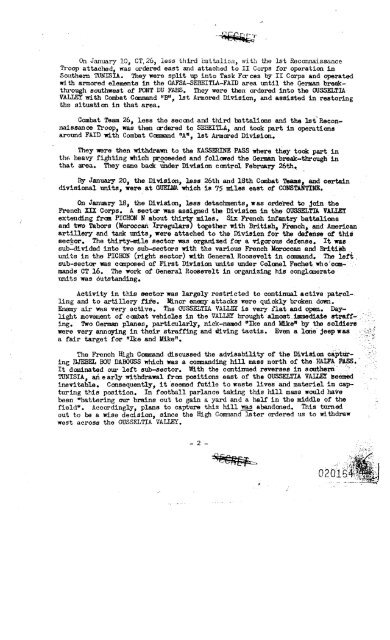KASSERINE PASS BATTLES Readings - US Army Center Of Military ...
KASSERINE PASS BATTLES Readings - US Army Center Of Military ...
KASSERINE PASS BATTLES Readings - US Army Center Of Military ...
Create successful ePaper yourself
Turn your PDF publications into a flip-book with our unique Google optimized e-Paper software.
On January 10, CT,26, less third cattalicn, wit; the 1st Reconnaissance<br />
Tx"oop attached, ryas ordered east and attached to II Ccrps for operation in<br />
Southern TUNISIA . They were split up into Task Fcr ces by II Corps and operated<br />
with armored elements in the GAFSA-SEBEITLA-FAIR area until the German breakthx"ough<br />
southwest of PONT DU FANS, They were then ordered into the O<strong>US</strong>SELTIA<br />
VALLEY with Combat Command "B", 1st Armored Division, and assisted in restoring<br />
the situation in that area .<br />
Combat Team 26, less the second and third battalions and the lst'Reconnaissance<br />
Troop, was then ordered to SEBEITLA, and took part in operations<br />
around FAIR with Combat Command "A", 1st Armored Division .<br />
They were then withdrawn to the <strong>KASSERINE</strong> <strong>PASS</strong> where they took part in<br />
the heavy fighting which proceeded and followed the German break-through in<br />
that area . They came back under Division control February 26th .<br />
By January 20, the Division, less 26th and 18th Combat Teams: and certain<br />
divisional- units, were at GUELMA which is 75 miles east of CONSTANTINE.<br />
On January 18, the Division, less detachments, was ordered to join the<br />
French %I% Corps. A sector was assigned the Division in the O<strong>US</strong>SELTIA VALLEY<br />
extending from PICHON N about thi~ miles . Six French infantry battalions<br />
and two Tabors (Moroccan Irregulars) together with British, French, and American<br />
artillery and tank units, were attached to the Division for the defense of this<br />
sector . The thirty-mi.le sector was organized for a vigorous defense . It was<br />
sub--divided into two sub-sectors with the various French Moroccan and British<br />
units in the PICHON (right sector) with General Roosevelt in command. The left_<br />
sub-sector was composed of First Division units under Colonel Fechet:who'd :<br />
sands CT 16. The work of General Roosevelt in organizing his conglomerate<br />
units was 6utstanding.<br />
Activity in this sector was largely restricted to continual active patrol-_<br />
ling and to artillery fire . Minor enemy attacks were quickly broken dorm .<br />
Enomy air vas very active . The Or<strong>US</strong>SErTIA VALLE'f is very flat and open . Day<br />
light movement of combat vehicles in the VALLEY brought almost immediate straffi.ng.<br />
Two German planes, particularly, nick-named "Ike and Mike" by the soldiers<br />
were very annoying in their straffing and diving tactic . Even a lone jeep was<br />
a fair target for "Ike and Mike" .<br />
The French High Command discussed the advisability of the Division captor- _<br />
ing DJEBEL BOU DABO<strong>US</strong>S which was a commanding hill mass north o£ the HALFA <strong>PASS</strong> .<br />
It dominated our left sub-sector . With the continued reverses in southern`<br />
TUNISIA, an early withdrawal from positions east of the O<strong>US</strong>SELTIA VALLEY teemed<br />
inevitable . Consequently, it seemed futile to waste lives and materiel in capturing<br />
this position . In football parlance taking this hill mass would have<br />
been "battering our brains out to gain a yard and a half in the middle of the<br />
field" . Accordingly, plans to capture this hill _was abandoned. This turned<br />
out to be a wise decision, since the High Command later ordered us to withdraw<br />
west across the O<strong>US</strong>SELTIA VALLEY .

















